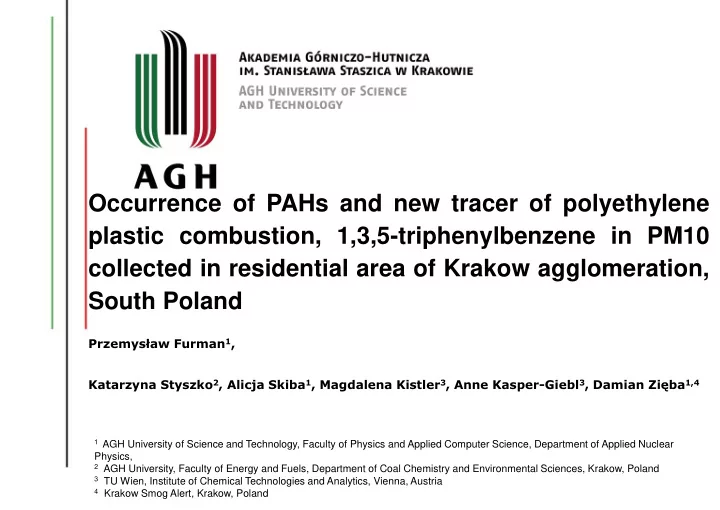

Occurrence of PAHs and new tracer of polyethylene plastic combustion, 1,3,5-triphenylbenzene in PM10 collected in residential area of Krakow agglomeration, South Poland Przemysław Furman 1 , Katarzyna Styszko 2 , Alicja Skiba 1 , Magdalena Kistler 3 , Anne Kasper-Giebl 3 , Damian Zięba 1,4 1 AGH University of Science and Technology, Faculty of Physics and Applied Computer Science, Department of Applied Nuclear Physics, 2 AGH University, Faculty of Energy and Fuels, Department of Coal Chemistry and Environmental Sciences, Krakow, Poland 3 TU Wien, Institute of Chemical Technologies and Analytics, Vienna, Austria 4 Krakow Smog Alert, Krakow, Poland
The problem of pollution in the Krakow agglomeration Combustion of Combustion solid fuels in of solid fuels the industrial in the sector municipal and housing Compact and sector low housing and Fig. 1. Smog in Krakow service development Geographical location and meteorological factors Fig. 2. PM10 map - Malopolska, Poland
Place of sampling Total area : 12,98km 2 Highest elevation : 318m Lowest elevation : 250m Population : - total: 19 149 - density: ~1 808/km 2 According to a report by the World Health Organization (WHO), in 2016 Wadowice was classified as the twentieth most polluted city in the European Union. Fig. 3. Wadowice, Poland
Sampling Fig. 4. Low-volume sampler PNS-15
Fig. 5. Gas chromatography mass spectrometry
Results
Chemical composition PM10 - March Chemical composition [µg/m 3 ] 120 30 100 25 Wind speed [km/h] 80 20 60 15 40 10 20 5 0 0 1.03.2017 6.03.2017 11.03.2017 16.03.2017 21.03.2017 26.03.2017 31.03.2017 Chemical composition PM10 Wind speed Chemical composition PM10 - August 40 20 Chemical composition [µg/m 3 ] Wind speed [km/h] 30 15 20 10 10 5 0 0 01.08.2017 06.08.2017 11.08.2017 16.08.2017 21.08.2017 26.08.2017 31.08.2017 Chemical composition PM10 Wind speed
Percentages of individual PAHs March 2017 August 2017 Average Average Percentage in Percentage in Chemical compound concentrations concentrations the PAH the PAH of compounds of compounds mixture, % mixture, % ng/m 3 ng/m 3 Acenaphthylene 0,45 0,53 - - Fluorene 0,62 0,74 - - Phenanthrene 2,34 2,78 0,45 4,24 8,17 9,71 0,75 7,06 Pyrene Benzo(a)anthracene 11,91 14,15 1,20 11,30 Chrysene 10,37 12,32 1,04 9,79 Benzo(b)fluoranthene 11,14 13,25 1,62 15,25 Benzo(k)fluoranthene 5,60 6,66 0,81 7,64 11,09 13,18 1,45 13,65 Benzo(a)pyrene Indene(1,2,3-cd)pyrene 8,53 10,14 1,44 13,56 Dibenzo(a, h)anthracene 11,46 13,62 1,86 17,51 Benzo(g,h,i)perylene 2,46 2,92 - - Total: 84,14 100 10,62 100
Exposure indicators of PAHs MEQ CEQ TEQ MEQ – mutagenic equivalent Place ng/m 3 ng/m 3 ng/m 3 CEQ – carcinogenic equivalent 22,08 72,23 0,094 Wadowice March 2017 Poland August 2017 3,05 11,27 0,014 TEQ – toxic equivalent Winter 2007 20,07 59,75 0,106 Delhi India 7,87 23,09 0,043 Summer 2007/2008 Winter 2008 4,91 3,64 0,016 Zagrzeb Croatia 0,14 0,10 0,001 Summer 2007 Winter 2009/2010 2,17 5,43 0,012 Florence Italy 0,54 1,54 0,003 Summer 2009/2010 March (A) Total concentrations of carcinogenic hydrocarbons, ng/m 3 70,10 (B) Total concentrations of all aromatic hydrocarbons, ng/m 3 84,14 Ratio (A) / (B) 0,83 August (A) Total concentrations of carcinogenic hydrocarbons, ng/m 3 9,42 (B) Total concentrations of all aromatic hydrocarbons, ng/m 3 10,62 Ratio (A) / (B) 0,89
1,3,5 - triphenylbenzene In March, for the first week, the March concentration of 1,3,5-triphenyl benzene in the air remained constant at 0,31 ng/m 3 . Concentration of 135TFB in individual Average concentration August weeks, ng/m 3 ng/m 3 Chemical compound 01-06 07-13 14-20 21-27 28-31 March August 1,3,5-triphenylbenzene 0,26 0,26 0,26 0,34 0,31 0,99 0,29
Conclusions 1. The concentrations of PM10 in March was much above the daily limit value (50µg/m 3 )( 15 days). In August, concentration of PM10 did not exceed the acceptable standards. Acceptable level of PM10 may be exceeded within a year for 35 days . Higher daily temperatures and higher wind speed were conducive to the occurrence of lower concentrations of PM10. 2. The average concentration of OC and EC recorded in colder month of 2017 was 19,38 µg/m 3 and 4,28 µg/m 3 , while in warmer month was 6,79 µg/m 3 and 1,79 µg/m 3 . 3. Concentrations of PAHs in March ( 84,14ng/m 3 ) was 8 times higher than in August ( 10,62ng/m 3 ). 4. The analyses showed an 7 times higher concentration of carcinogenic PAHs in March ( 70,10ng/m 3 ) than in August ( 9,42ng/m 3 ). 5. Analyses confirmed the presence of 1,3,5-triphenylbenzene, in whole measuring period, and its average concentration was 0,99ng/m 3 and 0,29ng/m 3 , in March and August, respectively. 135TPB is one of many exhaust gas components caused by burning of polyethylene plastics (mainly plastic bags).
Thank you for your attention Acknowledgement This presentation is based upon work from COST Action COLOSSAL supported by COST (European Cooperation in Science and Technology)
Recommend
More recommend